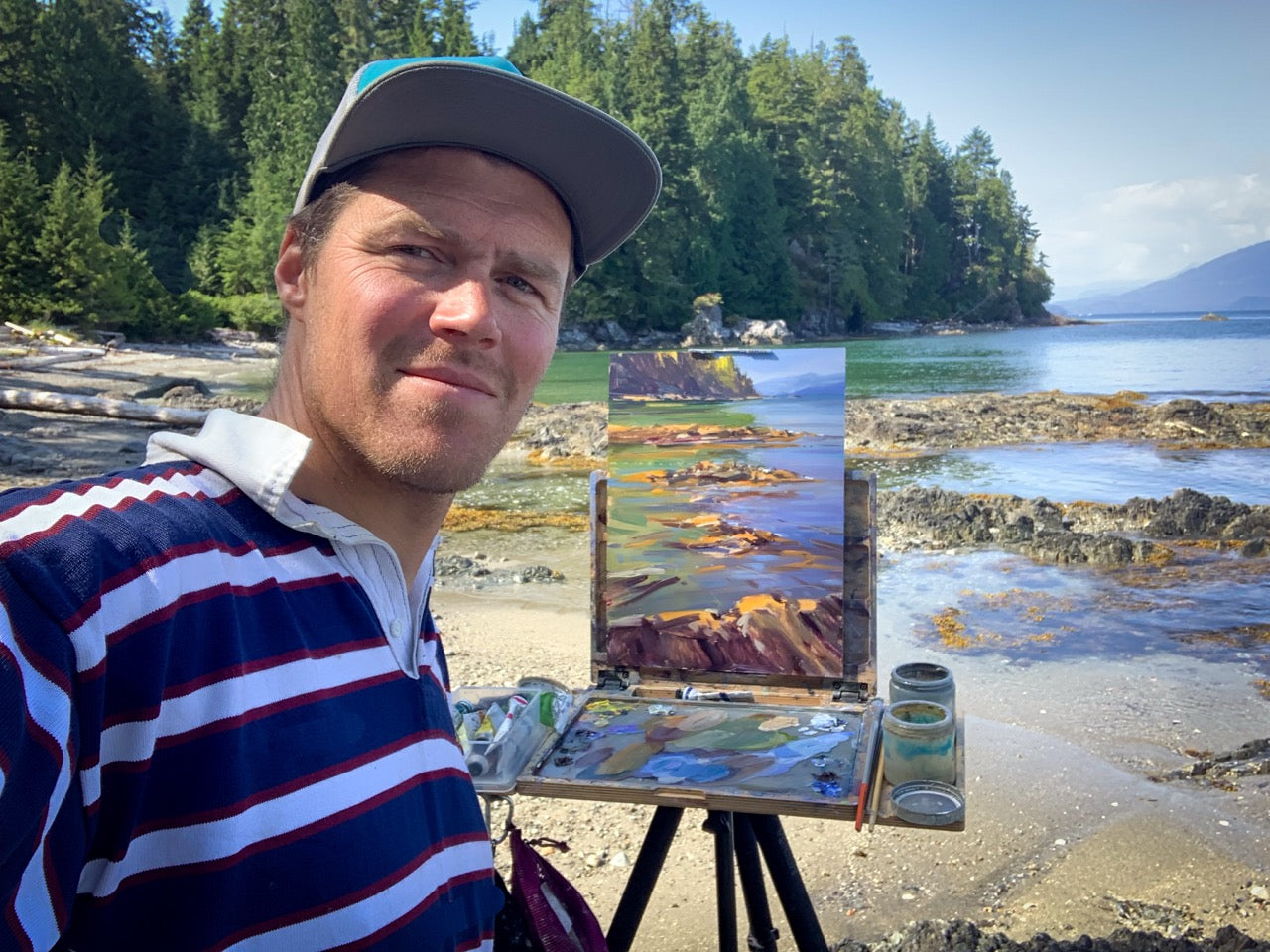Brushes packed. Boots laced. Panel ready. Charlie Easton heads into the wild to paint the places that move him. Bold adventures begin with a view, a brushstroke, and the freedom to create anywhere.
What does it take to pack up your paints and head into the wild? For Vancouver-based artist Charlie Easton, plein air painting is more than just working outdoors—it’s about embracing uncertainty, connecting deeply with the landscape, and finding joy in the process. Whether he’s hiking into remote mountain terrain or setting up on a windy coastline, Charlie brings a thoughtful, intuitive approach to capturing the natural world.
Watch the video to learn more about Charlie's bold adventure, and read the article to dive deeper into what he likes to bring out painting—his favourite brushes, colours, surfaces, and the mindset that guides his creative process.
Artist Q&A with Charlie Easton
What are your current go-to art supplies when painting outdoors?
I have three different sets of paint that I take with me: gouache, acrylic, and oil. I tend to use whatever artist-grade paint I can get my hands on, and Opus certainly offers some great painting options. In all my setups, I generally take the same colours: a selection of warm and cool colours. The warm ones look like you'd be painting a fire; the cool ones, like you'd be painting a glacier.
If I go through the colours, I always bring white. On the cool side, I take phthalo green, some kind of cyan or cerulean blue, ultramarine blue, and a dark dioxazine violet. On the warm side, I pack quinacridone magenta, cadmium orange, cadmium yellow light, and a brown. For acrylics, I like violet oxide because I can tint it warm or cool-it straddles a nice divide. That doesn't really exist in oil, so there I use burnt sienna or raw umber.
For surfaces, I love painting on wooden birch panels that have been primed with gesso and maybe a bit of warm acrylic paint. That gives me a neutral, maybe warm-ish mid-tone background. I don’t like working off white-it makes judging values trickier. Starting with a mid-tone means I can go both lighter and darker.
What about brushes-do you have a favourite?
Absolutely. For acrylics, I really like using the Opus Denman brushes-especially the angled chisel ones. They’re super versatile: I can make both fine and bold marks with them. I like longer bristles since they hold more paint. Outside of Opus, I also use Princeton Aspen brushes. The Opus Mezzo brushes are excellent too-they have great spring, ideal for oil paint. And the yellow-handled ones (Arietta) are great for softer work in the studio.
How do the Denman brushes hold up in the field?
They’re great. When I’m painting alla prima outdoors - meaning I’m finishing the painting in one go-I want stiffer brushes that leave great marks. That’s where the Denmans shine. If I’m layering, I reach for softer brushes. But for a single-layer plein air session, those stiffer brushes are perfect. I love how they leave texture and relief in the paint-they make arcs and create space within the brush marks.
Do you have any unexpected tools in your plein air kit?
Not really for applying paint, but I always make sure to bring gear that protects my setup-an umbrella, straps, or something to weigh down or secure everything if it’s windy. I also bring survival essentials like sunscreen, water, a hat, and extra layers. Being prepared means I can paint safely and comfortably.
How do you adapt your kit depending on the location or weather?
I definitely change things up depending on the situation, but I always keep a core set of items. I hang all three paint kits on the back of my studio door, so I can just grab and go. That minimizes the time between leaving the studio and actually starting to paint. Too many people spend half the day assembling their plein air kit from studio supplies. If your pack is ready to go, you’ll be the first one painting.

What are your top tips for packing light without compromising quality?
A good easel and tripod are key-lightweight and modular ones. French easels are often too heavy. I also cut down the number of paintbrushes-usually just two or three per session. And for oil painting, I limit the amount of solvent or medium I bring. Unless it’s a multi-day trip, you can usually get by with less than you think.
Do you always use the same colour palette, or does it vary?
I make sure I have the same core palette every time. I might add one or two colours depending on where I’m going. If I’m painting ocean scenes, I pack more ultramarine blue and green. If I’m headed to paint red rocks in Utah, I bring more earth colours. So the colours stay the same, but I adjust the quantities.
What does a “bold adventure” mean to you as an artist?
That’s a great question. It’s really all of those things - where I go, how I work, and my mindset. I like going to remote places that are awe-inspiring. When I’m there, I paint intuitively. It’s not about making a good painting; it’s about enjoying the experience. That mindset is really important to my practice. A bold adventure also means embracing uncertainty and letting go of control. It could be hiking to a challenging location, dealing with unpredictable weather, or trying something unfamiliar with my materials. It’s about stepping outside of routine and leaning into curiosity, wherever it takes me. I find that when I do go into a remote place and I’m accessing the nature of the awe-inspiring quality, I work in a very intuitive way. It becomes less about trying to do a good painting and more about how to enjoy the experience as much as I possibly can. A bold artistic adventure can mean letting go and being as free as possible when interpreting a place, without the constraints that come with our day-to-day routines.


How does painting outdoors affect your creative process?
Painting outside is going to the source. It’s where the inspiration starts-where our reactions and interpretations of a place happen in real time. I love it. I definitely want to do a good painting, but more importantly, I want a good experience. That energy stays with me and carries into the studio, where I can be more refined.
How do you choose a location to paint?
It’s a bit of everything. Sometimes I plan, especially for remote trips. Other times, I just go somewhere and see what catches my eye. I usually don’t have a specific view in mind, just a destination. When I arrive, I let the location guide me. There’ve been times I skipped the “classic view” entirely because the way light hit a rock was more interesting.
Can you share a favourite plein air memory?
Yeah, I was painting in Arizona with my wife and our at that time one-year-old. My wife was walking around with our daughter on her back. And a truck pulled up, and the guy started yelling, “Get off my land! You’re poaching pigs!” He thought my easel was a rifle, and my daughter in my wife’s backpack was a pig! He immediately calmed down when he realized that we were the most unthreatening kind of people on his land.". An artist and a mother with a young kid to make it. And now my daughter will forever not be known as the pig that was poached.

What are your top three plein air locations?
Number one has to be Lake O’Hara - so much variety, massive rock faces, glacial lakes, and snow-capped peaks. There are endless compositions to be found in every direction, and the way the light changes throughout the day is always inspiring. It also offers a sense of solitude and scale that’s hard to match.
The area around Assiniboine is also stunning for similar reasons.
And third would be the west coast of Vancouver Island, where I’ll actually be doing an Opus demo. The drama of the landscape—the crashing waves, misty forests, and rugged coastline—creates a powerful emotional response. Every trip out there feels like a real adventure, and I always come back with something meaningful, whether that’s a finished painting or just a memory burned into my mind.
What’s a common misconception about plein air painting?
That you have to do a good painting. Absolutely not. It’s about the process - about interpreting the landscape with your skills. When you give yourself over to the process, the painting becomes secondary but still meaningful. Sometimes you capture that magic; other times, it just becomes a precious memory. I rarely produce a gallery piece in one plein air session - it usually needs refining later.

Do you have any rituals or habits that help you stay creatively grounded while travelling?
I want to paint all the time - it’s really important to me, and my family knows that. Before a trip, we talk about when I’ll get time to paint. In return, I also make sure I’m present for family time. And the more you paint, the better it gets - you get more intuitive and fluent with your process. Just keep painting.
How has painting outdoors changed how you see the world?
I’ve become much more observational. When I paint somewhere, I remember everything about it - how I felt, what I saw. It helps me be more present and engaged. And especially here in BC, it’s deepened my connection to nature. Painting outdoors turns you into an advocate. The more you appreciate the wild, the more you want to protect it. If I go somewhere and do a painting, I remember the specifics of the scene so vividly—it’s like the act of painting imprints the moment in my memory. It feels like I’ve been doing this my whole life, like it’s part of who I am. Spending time immersed in nature has also helped me better understand the natural aspects of my surroundings and strengthened my desire to preserve the wild and sacred places we still have.


